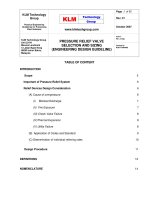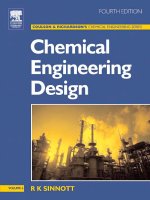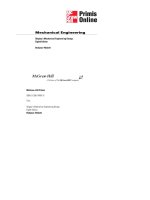Neoweb® Slope Protection Engineering Design
Bạn đang xem bản rút gọn của tài liệu. Xem và tải ngay bản đầy đủ của tài liệu tại đây (4.7 MB, 59 trang )
Neoweb® Slope Protection
Engineering Design
Engineering Seminar, PRS
July 2010
Neoweb® Slope
Protection System
•
•
•
•
Reinforced cover protection
Erosion control for stable slopes
Extend local stability life-span
Vegetated landscape solution
Section I
INPUT
•
•
•
•
•
Checklist
Project Plans
Objectives - Client’s preferences
Goal & Cost
Slope Definition
I - INPUT
Checklist
• Summary of design properties
• Includes most/all design properties
• Enables relatively quick design for preliminary
evaluation
I - INPUT
Project Plans
• Advantages
– Alternative solutions
– More details – enables more customized solution for
specific site conditions
– Confirm design checklist – questions
I - INPUT
Objectives - Client’s Preferences
• Understanding main objectives of client
Preferences, e.g.:
– Min. cover thickness for vegetation
– Min. cover thickness for geomembrane protection
– Type of surface cover protection
• Vegetated
• Granular
• Concrete
I - INPUT
Goal & Cost
• Cost of alternative solutions (if any)
per sqm or linear meter of solution
• Determine go/no-go
I - INPUT
Slope Definition
(1) Slope Type:
I - INPUT
Slope Definition
(2) Geometry:
•
•
•
•
Height
Inclination
Crest Area
Toe Area
I - INPUT
Slope Definition
Sub-base / Native Soil:
•
•
•
•
Description,
Internal friction angle φ [°]
Cohesion C [kPa]
Unit weight γ [kN/m3]
Why?
• Examining slope global stability
• Evaluating stakes resistance
I - INPUT
Slope Definition
Loads / Actions on Slope:
•
•
•
•
•
•
•
Loads on slope, e.g. snow
Loads on crest
Surface runoff
Concentrated runoff
Ground water seepage
Wave action
Ice action
Section II
Slope Stability Examination
• Examining global slope stability for rotationalcircular failures
• Not considering Neoweb cover
• Target: ensuring the Neoweb is on a stable slope
II - Slope Stability Examination
• Circular-Rotational Failure:
– Large mass of soil rotates and fails
II - Slope Stability Examination
Why?
• Poor soil properties:
– Low friction angle
– Low cohesion under saturated
condition
• Challenging geometry:
– Height & inclination
• Crest loads
II - Slope Stability Examination
Is the slope stable based on:
• Geometry
• Soil Properties
• Loads / Actions…
II - Slope Stability Examination
• Unstable Slope - Circular Failure
• Factor of Safety < 1.30
II - Slope Stability Examination
• Stable Slope - Circular Failure
• Factor of Safety ≥ 1.30
II - Slope Stability Examination
• Effect of different soil properties on
identical slope geometries
Good soil properties
Poor soil properties
II - Slope Stability Examination
Stability
Examination
Slope is
Stable
Slope is
Not stable
Slope
Protection
System
Earth
Retention
System
II - Slope Stability Examination
Example of Stable Slopes (FS ≥1.30):
HEIGHT
INCLINATION
FRICTION ANGLE*
COHESION*
[m]
Ratio [V:H]
[degrees]
[kPa]
3
1V:2H (26.6º)
2V:3H (33.7º)
1V:1H (45.0º)
24º
24º
24º (32º)
1.5
3.0
5.0 (3.0)
5
1V:2H (26.6º)
2V:3H (33.7º)
1V:1H (45.0º)
24º
29º
32º
2.5
3.0
5.0
7
1V:2H (26.6º)
2V:3H (33.7º)
1V:1H (45.0º)
24º
25º
28º
3.5
6.0
9.0
10
1V:2H (26.6º)
2V:3H (33.7º)
1V:1H (45.0º)
24º
26º
28º
4.5
8.0
13.0
* Properties of cut/native slope soil at saturated state
II - Slope Stability Examination
Eroded slope Example
- solution is possible with Neoweb
slope protection system
II - Slope Stability Examination
Global slope failure – needs retention of the
slope utilizing Neoweb Earth Retention System
Section III
Neoweb Slope Protection Design
•
•
•
•
•
Defining Neoweb Infill Type
Defining Neoweb product: cell size and height
Calculating Downslope Driving Force
Calculating Downslope Resisting Forces
Customizing Anchorage System for sufficient
Factor of Safety
III – Neoweb Design
Types of Infill Protection:
Vegetated Topsoil
Granular
Topsoil-Granular
Concrete
III – Neoweb Design
Neoweb Infill Properties:
•
•
•
•
Description,
Internal Friction Angle φ [°]
Cohesion C [kPa]
Unit Weight γ [kN/m3]
• Hydro seed / planted vegetation









